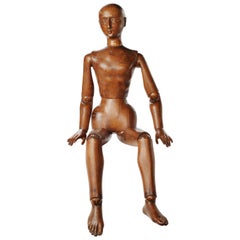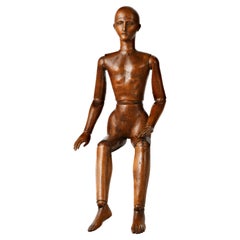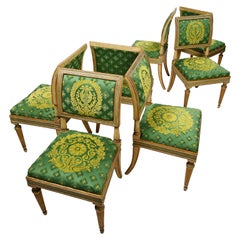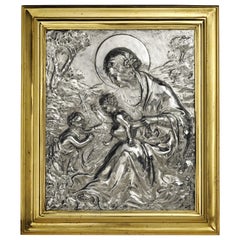Want more images or videos?
Request additional images or videos from the seller
1 of 21
Late 19th or Early 20th Century Italian Three-Masted Steam-Frigate Model
$3,591.84List Price
About the Item
- Dimensions:Height: 22.84 in (58 cm)Width: 33.86 in (86 cm)Depth: 10.24 in (26 cm)
- Style:Other (Of the Period)
- Materials and Techniques:
- Place of Origin:
- Period:
- Date of Manufacture:circa 1900
- Condition:Minor structural damages. Minor fading. A glued bowsprit tip and a few additions to the rigging.
- Seller Location:Milano, IT
- Reference Number:1stDibs: LU4352216204012
About the Seller
4.3
Vetted Professional Seller
Every seller passes strict standards for authenticity and reliability
Established in 1860
1stDibs seller since 2018
21 sales on 1stDibs
Associations
International Confederation of Art and Antique Dealers' Associations
Authenticity Guarantee
In the unlikely event there’s an issue with an item’s authenticity, contact us within 1 year for a full refund. DetailsMoney-Back Guarantee
If your item is not as described, is damaged in transit, or does not arrive, contact us within 7 days for a full refund. Details24-Hour Cancellation
You have a 24-hour grace period in which to reconsider your purchase, with no questions asked.Vetted Professional Sellers
Our world-class sellers must adhere to strict standards for service and quality, maintaining the integrity of our listings.Price-Match Guarantee
If you find that a seller listed the same item for a lower price elsewhere, we’ll match it.Trusted Global Delivery
Our best-in-class carrier network provides specialized shipping options worldwide, including custom delivery.You May Also Like
19th Century Three-Masted Sailboat Model
Located in LA CIOTAT, FR
This exquisite, meticulously crafted wooden ship model is a stunning representation of a three-masted sailing vessel. The hull is painted a deep crimson with accents of natural wood,...
Category
Antique 19th Century French Models and Miniatures
Materials
Fruitwood
French Wooden Scale, Late 19th-Early 20th Century
Located in Atlanta, GA
Having a large weighing surface and a smaller side for weights.
Category
Early 20th Century French Scientific Instruments
C. Late 19th-Early 20th Century American Carousel Horse on Custom Stand
Located in Chapel Hill, NC
Late 19th-early 20th century carousel horse on custom stand, American. A fine & fun example. Restored prior to the current owner's acquisition of it, it likely had handles to mount &...
Category
Antique Late 19th Century American Other Historical Memorabilia
Materials
Wood, Oak
$1,950
H 56 in W 43 in D 18.75 in
Late 19th-Early 20th Century Brass Judaica Wall Brackets
Located in San Francisco, CA
Late 19th-early 20th century brass Judaica wall brackets
Dimensions 4.5" wide x 10" deep (away from wall) x 10" high
Very good antique condition.
...
Category
Antique Late 19th Century American Wall Brackets
Materials
Brass
20th Century Diorama Folk Art Three Mast Model Ship in a Bottle English, C 1930
Located in Central England, GB
A fine Diorama Folk Art Model ship in a bottle
This skilfully made diorama of a three-mast early 19th century sailing ship at harbour with a raised landscape behind and cottages set...
Category
20th Century English Folk Art Nautical Objects
Materials
Glass
$843
H 3.55 in W 9.45 in D 2.96 in
Library Terrestrial Globe On Stand, Late 19th Early 20th Century
Located in MARSEILLE, FR
Large terrestrial globe in papier maché and plaster, fixed in its wooden basket: the spindles are painted with the continents (decoratively), the complete meridian is in brass; the h...
Category
Antique Late 19th Century Italian Renaissance Scientific Instruments
Materials
Wood, Paper
A Cast Iron Cobbler's Shoe Anvil, Late 19th Century to Early 20th Century
Located in ARMADALE, VIC
A Cast Iron Cobbler's Shoe Anvil, Late 19th Century to Early 20th Century
The cast iron foot mould mounted atop a rectangular timber base.
Dimension: Height: 26cm Width: 40cm Depth...
Category
Early 20th Century British Models and Miniatures
Materials
Iron
$330
Free Shipping
H 10.24 in W 15.75 in D 5.71 in
Late 19th Early 20th Century Japanese Textile Swatch Book, Komon (Book)
Located in North Yorkshire, GB
Dating from around 1900, this is a delightful album which has a collection of Japanese dyed cotton fabric swatches known as Komon. Komon was a Japanese design or pattern based on ver...
Category
Antique Late 19th Century Books
Materials
Paper
$3,500
Free Shipping
H 10.75 in W 8.5 in D 1 in
Three Masted Schooner Ship Model
Located in Norwell, MA
Model of a three-masted cargo schooner with a red and black painted hull. Scribed deck with cabins, hatches, wheel, stovepipe, winch, anchors, etc. Model is by Honore Leclerc of Cana...
Category
Vintage 1960s North American Models and Miniatures
Materials
Wood
American Three Masted Clipper Ship Model Sovereign of the Seas Under Glass, 20th
Located in Charleston, SC
American three masted clipper ship model displayed in a mahogany glass case. She was the fastest ship ever built in 1852. California clipper ship mo...
Category
20th Century American American Empire Nautical Objects
Materials
Glass, Mahogany, Pine, Paint
$12,500
H 30.75 in W 42.75 in D 16.75 in
More From This Seller
View AllLate 19th Century Italian Wood Mannequin, circa 1880
Located in Milano, IT
Atelier mannequin
graven and carved stone pine wood
Italy, late 19th century
Measures: H 102 cm x 25 cm x 14 cm
H 40.15 in x 9.84 in x 5.51 in
Weight: circa kg 4
State of conse...
Category
Antique 1880s Italian Other Figurative Sculptures
Materials
Wood
19th Century Italian Wood Mannequin, Circa 1870-1880
Located in Milano, IT
Mannequin
Sculpted and carved wood
Italy or France, second half of the 19th century.
It measures 25.59 x 6.29 x 3.54 in (65.5 x 16 x 9 cm)
It weighs 2.2 lb circa (1 kg circa)
St...
Category
Antique 1870s Italian Other Figurative Sculptures
Materials
Wood
Seven Early 19th Century Neoclassical Italian Chairs, Milan circa 1820
Located in Milano, IT
Group of seven chairs
Milan, first quarter of the 19th century
Carved walnut wood, lacquered in gray green and cream and partially gilded
They measure:
height 36.61 in (18.11 in ...
Category
Antique 1810s Italian Neoclassical Chairs
Materials
Walnut
19th Century Italian Sterling Silver Madonna, circa 1830
Located in Milano, IT
Embossed and engraved silver plaque
La Madonna del lago (The Madonna of the Lake)
Probably Milan, post 1824
Brass frame
It measures 16.14 in x 13.85 in (41 x 35.2 cm) and it weighs 10.357 pounds (4.698 g): silver 1.31 pounds (598 g) + brass 9.03 pounds (4.100 g)
State of conservation: some abrasions on the bottom. The frame is old, but not original.
The plaque is made up of a sheet of embossed and engraved silver, and held in a solid brass frame. It depicts the “Madonna del lago” – “Madonna of the Lake” - (the Madonna with Child and San Giovannino) by Marco d'Oggiono (Oggiono, 1474 circa - Milan, 1524 circa), while changing only the background landscape. Almost certainly the subject reproduced in the plaque was taken from a famous engraving by Giuseppe Longhi (Monza, 1766 - Milan, 1831), one of the greatest engravers of his era.
The silver is unmarked, probably because originally the Madonna was due to be exposed in a church: sometimes precious metals destined for worship and liturgical use would be exempted from payment and were, therefore, not marked.
It is very likely that the plaque was made in Milan because in this city in 1824 the engraving by Giuseppe Longhi was made and printed. In addition, in Milan, the alleged lost painting by Leonardo da Vinci in his Milanese period (1482-1500) would be produced; this is the painting from which Marco d'Oggiono took his version.
The painting
Marco d?Oggiono was one of Leonardo da Vinci's most brilliant students and collaborators (D. Sedini, Marco d’Oggiono, tradizione e rinnovamento in Lombardia tra Quattrocento e Cinquecento, Roma 1989, pp. 151-153, n. 56; p. 225, n. 124, with previous bibliography). His style reflects in every way that of the Tuscan Maestro, so much so that he was the one who executed some copies of da Vinci's paintings. The execution of the “Madonna del Lago” probably draws inspiration from a lost painting by the Maestro, created while he was living in Milan (1482-1500). There are many similarities with other works by Leonardo such as the “Vergine delle rocce” or the “Vergine con il Bambino e San Giovannino, Sant’Anna e l’Agnello”.
The painting, from which the drawing and then the famous engraving were taken, is found today at the M&G Museum of Bob Jones University in Greenville, South Carolina, where it came to rest after the sale of the Harrington Collection in London in 1917.
The work appears in the inventories of the collection of Napoleon and Joséphine Bonaparte at the castle of Malmaison, before 1809.
The Malmaison building was born and developed in the 17th and 18th centuries. In the 18th century it belonged to Jacques-Jean Le Coulteux du Molay, a wealthy banker. Later, during the Directory, Joséphine Bonaparte de Beauharnais bought it on April 21st, 1799, but settled at the castle definitively only after her husband separated from her in 1809. She remained there until 1814, the year of her death. When Joséphine died, the estate passed to her son Eugène de Beauharnais, who moved to Munich with his whole family in 1815, bringing with him the collection of paintings he inherited from his mother. Eugène died in 1824 and his wife Augusta of Bavaria (von Bayern), unable to keep it, in 1828 sold the Malmaison to the Swedish banker Jonas-Philip Hagerman.
It is likely that in this period Augusta also sold part of the paintings inherited from her husband, including the “Madonna del Lago”. This painting then came into the possession of Leicester Stanhope, fifth Earl of Harrington (1784 - 1862) and then was passed down to his descendants.
In 1917, at the death of Charles, eighth Earl of Harrington, his brother Dudley inherited the title and properties and he put up a part of his collections for sale. Among these, precisely, the painting by Marco d'Oggiono was to be found.
On the occasion of that auction the painting was presented as a work by Cesare da Sesto, by virtue of a handwritten note by the Countess of Harrington on the back of the table. However, already in 1857, the German critic Gustav Waagen had identified Marco d'Oggiono as the author of the painting, then exhibited in the dining room of Harrington House in London (Treasures of Art in Great Britain, in 4 volumes, London, 1854 and 1857).
The engraving
Giuseppe Longhi was one of the most renowned engravers in Italy between the end of the 18th century and the first quarter of the 19th century.
In 1824 Giuseppe Longhi, based on a design by Paolo Caronni, made a famous engraving of the painting of Marco d?Oggiono. The activity of Longhi was then at the peak of his notoriety, enough to earn him very substantial commissions; it is not risky to suppose that some of his successful engravings were also reproduced using other means: in our case in silver. (A. Crespi, a cura di, Giuseppe Longhi 1766–1831 e Raffaello Morghen...
Category
Antique 1820s Italian Neoclassical Sterling Silver
Materials
Sterling Silver, Brass
Ancient Boxwood Micro Carving Deposition, First Half of the 18th Century
Located in Milano, IT
Boxwood micro carving
Deposition
Central Europe, first half of the 18th century
It measures: the sculpture 7.40 x 5.31 x 0.6 in (18.8 x 13.5 x 1.6 cm); w...
Category
Antique 1740s European Baroque Figurative Sculptures
Materials
Boxwood
Maiolica flower pots Samson & Fils Factory, France, late 19th century
By Emile Samson
Located in Milano, IT
Maiolica flower pots “a mezzaluna”
Samson & Fils Factory
Montreuil-sous-Bois, France, late 19th century
They measure 4.72 in in height x 8.66 x 5.03 (12 cm x 22 x 12,8)
Weight: 1.88...
Category
Antique Late 19th Century French Rococo Planters, Cachepots and Jardinières
Materials
Maiolica
Recently Viewed
View AllMore Ways To Browse
Antique Steam Engine
Steam Models
Model Frigate
Miniature Antique Collectibles
Trunk Feet
Gufram Cactus
Miniature Chairs
Carved Wood Miniature
Antique Salesman Samples
Wood Ship Model
Miniature House
Miniature Car
Ship Models Miniature
Antique Ship Models
Chest Game Antique
Salesman Samples Furniture
Carved Wooden Bar
Large Scale Models



